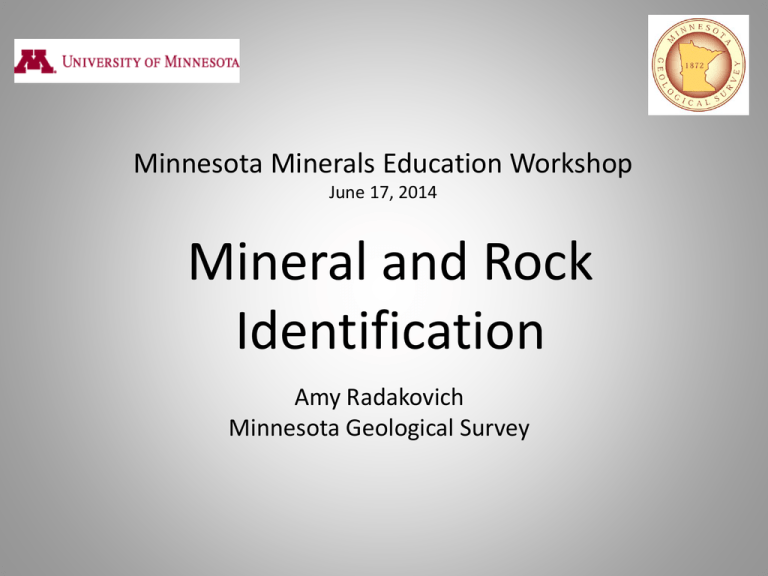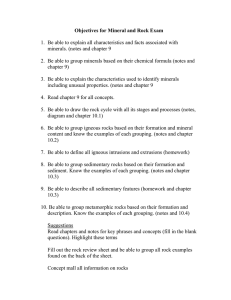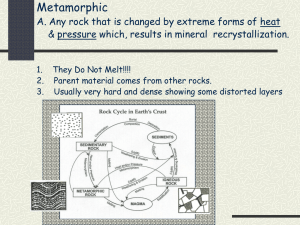Mineral and Rock Identification Minnesota Minerals Education Workshop Amy Radakovich
advertisement

Minnesota Minerals Education Workshop June 17, 2014 Mineral and Rock Identification Amy Radakovich Minnesota Geological Survey Introduction to Rock Forming Minerals All minerals meet these six criteria: 1. 2. 3. 4. 5. 6. June 17, 2014 Naturally occurring (not man-made) Inorganic (no plant matter) Homogeneous (must be the same throughout) Solid (no liquids) Definite (but variable) chemical composition Ordered internal arrangement of atoms MMEW Rock and Mineral Identification: Amy Radakovich - Minnesota Geological Survey Identifying Minerals • Many rock properties can be assessed very easily in a classroom • • • • Color Streak Hardness Specific Gravity • Magnetism • Luster • Cleavage Note: Where applicable, image citations are listed in the presentation notes for each slide June 17, 2014 MMEW Rock and Mineral Identification: Amy Radakovich - Minnesota Geological Survey Mineral Properties: Color • Color comes from the chemical composition of a mineral • Easy to identify, but not always reliable – Some minerals have an inherent color and are always the same – But some minerals come in a variety of colors based on presence of trace elements Exhibit A: All fluorite! June 17, 2014 MMEW Rock and Mineral Identification: Amy Radakovich - Minnesota Geological Survey Mineral Properties: Streak • Streak is the color a mineral produces when ground to a fine powder • Much more reliable than mineral color, because each mineral has a diagnostic streak color, no matter the color of the mineral itself • Note: many minerals do not produce a streak • Test streak by marking the mineral on a white porcelain streak plate – press firmly! June 17, 2014 MMEW Rock and Mineral Identification: Amy Radakovich - Minnesota Geological Survey Mineral Properties: Hardness • The hardness of a mineral is a factor of the strength of the chemical bonds within the mineral • Hardness is shown by a mineral’s ability to resist or inflict abrasion (a scratch) on or by another mineral • Hardness is measured from 1 (softest) through 10 (hardest) on the Moh’s Hardness Scale • Hardness is tested by scratching a mineral against various reference materials June 17, 2014 MMEW Rock and Mineral Identification: Amy Radakovich - Minnesota Geological Survey Hardness Test • Use common classroom materials to test the hardness of minerals • If a mineral can be scratched by your fingernail, its hardness is: Less than 2.5 ____________ • If a mineral scratches a streak plate, its Greater than 7.0 hardness is: ________________ • If a mineral can scratch glass but can be scratched by a steel file, its hardness Between 5.5 and 6.5 must be: __________________ June 17, 2014 MMEW Rock and Mineral Identification: Amy Radakovich - Minnesota Geological Survey Mineral Properties: Specific Gravity • Specific gravity of a mineral is its density (ρ) relative to water – Specific gravity = ρmineral ρwater • In a classroom, you can measure specific gravity by doing a density test or by a more subjective “heft test” – “Heft test”: Does the mineral feel heavier, lighter, or about what you’d expect based on its size? • Heavier = high specific gravity • Lighter = low specific gravity • About what you’d expect = medium specific gravity June 17, 2014 MMEW Rock and Mineral Identification: Amy Radakovich - Minnesota Geological Survey Mineral Properties: Magnetism • Magnetism is the ability of some minerals to behave like magnets • Magnetism is strongly related to iron content Assess magnetism by holding a magnet up to a sample and feeling if there is a “pull” when you move the mineral farther away. June 17, 2014 MMEW Rock and Mineral Identification: Amy Radakovich - Minnesota Geological Survey Mineral Properties: Luster • Luster refers to how a mineral reflects light • Mineral luster is classified generally as “metallic” or “non-metallic” – Metallic: looks like a metal – Non-metallic: does NOT look like a metal • Caution: can still be shiny! • Glassy, shiny, greasy, waxy, dull, earthy June 17, 2014 MMEW Rock and Mineral Identification: Amy Radakovich Minnesota Geological Survey Luster (continued) • Metallic June 17, 2014 • Non-metallic MMEW Rock and Mineral Identification: Amy Radakovich - Minnesota Geological Survey Mineral Properties: Cleavage • Cleavage describes the way a mineral breaks (cleaves) along planes of weakness in its atomic structure • Caution: Not all minerals have cleavage. Some minerals break or fracture in irregular ways • Cleavage does form: – Flat, reflective surfaces – Angular corners – Defined edges • Cleavage does NOT form: – Lumps & bumps – Irregular surfaces – Conchoidal fracture June 17, 2014 MMEW Rock and Mineral Identification: Amy Radakovich - Minnesota Geological Survey Cleavage (continued) • Minerals can have one, two, three, or even four different directions of cleavage depending on the strength or weakness of a mineral’s atomic bonds. • Multiple cleavage faces intersect each other at specific and predictable angles in certain minerals June 17, 2014 MMEW Rock and Mineral Identification: Amy Radakovich - Minnesota Geological Survey June 17, 2014 MMEW Rock and Mineral Identification: Amy Radakovich - Minnesota Geological Survey So, how many minerals should students be familiar with? • Important rock-forming minerals • • • • Quartz Plagioclase Orthoclase Hornblende • • • • Pyroxene Olivine Biotite Muscovite • Minerals with recognizable and diagnostic properties • • • • • June 17, 2014 Sulfur Pyrite Galena Magnetite Hematite MMEW Rock and Mineral Identification: Amy Radakovich - Minnesota Geological Survey Minerals to Rocks • All rocks are made up of minerals • Most rocks are composed of numerous minerals • Three types of rocks – Sedimentary – Igneous – Metamorphic • These three rock types are interconnected through the rock cycle. Erosion & weathering, heat, and pressure can transform any rock types into another, given enough time MMEW Rock and Mineral Identification: June 17, 2014 Amy Radakovich - Minnesota Geological Survey Sedimentary Rocks Sedimentary rocks form by deposition of sediment or precipitation of minerals at or near Earth’s surface. • Two types of sedimentary rocks • Clastic: form by cementing together fragments or grains of pre-existing rocks • Chemical: form when minerals precipitate out of water solutions at the earth’s surface June 17, 2014 MMEW Rock and Mineral Identification: Amy Radakovich - Minnesota Geological Survey Common Sedimentary Rocks Clastic Sandstone Conglomerate/Breccia Chemical June 17, 2014 Limestone MMEW Rock and Mineral Identification: MMEW Rock & Mineral Identification - Amy Amy Radakovich - Minnesota Geological Radakovich - Minnesota Geological Survey Survey Identifying Sedimentary Rocks • Grain Size – Fine, medium, or coarse-grained • Grain Sorting – Well or poorly sorted • Grain shape – Rounded or angular • Reaction with dilute HCl (Hydrochloric acid) – Fizzes readily, fizzes after being powdered, or does not fizz • Other “dead-giveaway” characteristics – Fossils – Layering June 17, 2014 MMEW Rock and Mineral Identification: Amy Radakovich - Minnesota Geological Survey Flow Chart for Sedimentary Rock Identification • This is a very comprehensive chart, but is probably a bit to detailed for elementary and middle school Earth science • The next slide is a much more simplified chart I made that might be a bit more appropriate with rock ID at this grade level June 17, 2014 MMEW Rock and Mineral Identification: Amy Radakovich - Minnesota Geological Survey Simplified Flow-chart for Identifying Sedimentary Rocks Reacts readily with HCl Limestone Reacts w/ HCl after being powdered Dolostone Sedimentary Chemical (reacts with HCl) Composed of grains Clastic Sand-size grains Sandstone Silt-size grains Siltstone Clay-size particles Shale Rounded clasts Conglomerate Angular clasts Breccia (does NOT react with HCl) Composed of clasts of different rocks June 17, 2014 MMEW Rock and Mineral Identification: Amy Radakovich - Minnesota Geological Survey Igneous Rocks • Rocks that solidified from a molten (or partially molten) material (magma or lava) • 2 kinds of igneous rocks – Intrusive (form below the earth’s surface) – Extrusive (form above the earth’s surface) June 17, 2014 MMEW Rock and Mineral Identification: Amy Radakovich - Minnesota Geological Survey Igneous Rock Formation • How does magma/lava turn into a rock? • Think about ice forming from water – Cools! – Solidifies! • How does a rock “solidify”??? – Grows crystals/minerals June 17, 2014 MMEW Rock and Mineral Identification: Amy Radakovich - Minnesota Geological Survey Minerals in Igneous Rocks • Mineral size is a factor of TIME – The more time a rock has to crystallize, the bigger the minerals can grow! • Extrusive (Volcanic) = quick cooling, fine-grained – No visible crystals - aphanitic • Intrusive (Plutonic) = slow cooling, coarse-grained – Crystals visible with the naked eye – phaneritic Fine-grained June 17, 2014 MMEW Rock and Mineral Identification: Amy Radakovich - Minnesota Geological Survey Coarse-grained Identifying Igneous Rocks • Grain size: Fine-, medium-, coarse-grained, or a combination fine medium coarse combination – porphyritic) • Color & Composition: determined by minerals present – Light (felsic) June 17, 2014 medium (intermediate) MMEW Rock and Mineral Identification: Amy Radakovich - Minnesota Geological Survey dark (mafic) Identifying Igneous Rocks (continued) • Other features 1 – Vesicles/Amygdules – Glassiness June 17, 2014 2 MMEW Rock and Mineral Identification: Amy Radakovich - Minnesota Geological Survey 3 Identifying Igneous Rocks (continued) This table can be VERY useful to help understand the similarities and differences of igneous rocks. However, a simplified flow chart like I created on the next slide often proves MUCH more helpful in the process of identifying igneous rocks. June 17, 2014 MMEW Rock and Mineral Identification: Amy Radakovich - Minnesota Geological Survey Simplified Flow-chart for Identifying Igneous Rocks Igneous Phaneritic (crystals visible to the naked eye) Aphanitic (no or few visible crystals) June 17, 2014 Felsic (light) Granite Intermediate (medium) Diorite Mafic (dark) Basalt Felsic (light) Rhyolite Intermediate (medium) Andesite Mafic (dark) Gabbro MMEW Rock and Mineral Identification: Amy Radakovich - Minnesota Geological Survey Metamorphic Rocks • Metamorphic rocks form when a rock is exposed to elevated temperature and pressure • Involves a change in texture or mineralogy in the solid state (in other words, the rock can’t re-melt) • Can form from an igneous rock, a sedimentary rock, or another metamorphic rock June 17, 2014 MMEW Rock and Mineral Identification: Amy Radakovich - Minnesota Geological Survey Common metamorphic rocks • The more heat and pressure you add, the more the rock changes • The most common structure developed in metamorphic rocks is foliaton, when minerals are aligned parallel to one another by deformation schist slate gneiss June 17, 2014 MMEW Rock and Mineral Identification: phyllite Amy Radakovich - Minnesota Geological Survey Identifying Metamorphic Rocks • Grain size (grain size usually increases with increasing metamorphism) • Foliation • Other features – Folding June 17, 2014 “Squished” appearance MMEW Rock and Mineral Identification: Amy Radakovich - Minnesota Geological Survey Simplified Flow-chart for Identifying Foliated Metamorphic Rocks NOTE: Remember, there are non-foliated metamorphic rocks such as quartzite and marble as well. If you have a lot of time to spend on metamorphic rocks, it’s wonderful to include those; I left them out here because in my experience, foliated metamorphic rocks help to visually display the metamorphic process best for students. Metamorphic Poorly foliated Slate June 17, 2014 Moderately foliated Phyllite Strongly foliated Schist MMEW Rock and Mineral Identification: Amy Radakovich - Minnesota Geological Survey Very strongly foliated and banded Gneiss General Rock Identification Many rock identification charts like this are available on the Internet, but I found it most helpful to create my own chart that helps students arrive at a rock name by eliminating possibilities in manageable steps (see next slide) …Hopefully this will help you in your classroom as well! This rock ID chart is a combination of the three shown previously for the three different rock types. June 17, 2014 MMEW Rock and Mineral Identification: Amy Radakovich - Minnesota Geological Survey Chemical (reacts with HCl) Reacts readily with HCl Limestone Reacts w/ HCl after being powdered Dolostone Sand-size grains Sandstone Silt-size grains Siltstone Clay-size particles Shale Rounded clasts Conglomerate Angular clasts Breccia Sedimentary Composed of grains Clastic (does NOT react with HCl) Composed of clasts of different rocks What type of rock is it? Phaneritic Felsic (light) Granite Intermediate (medium) Diorite Mafic (dark) Basalt Felsic (light) Rhyolite Intermediate (medium) Andesite Mafic (dark) Gabbro Igneous Aphanitic Poorly foliated Slate Moderately foliated Phyllite Strongly foliated Schist Very strongly foliated and banded Gneiss Metamorphic June 17, 2014 MMEW Rock and Mineral Identification: Amy Radakovich - Minnesota Geological Survey Questions? LAB TIME!!! June 17, 2014 MMEW Rock and Mineral Identification: Amy Radakovich - Minnesota Geological Survey # Color Streak Hardness Specific Gravity Mag Luster Cleavage Mineral Name 0 Grey Grey 1-1.5 Low N Non-metallic 1 graphite 1 Silver Dk. Grey 2.5-2.75 high metallic Cubic (3 @ 90) Galena 2 Gold Black/grey 6-6.5 High weak Metallic Cubic (3 @ 90) Pyrite 3 Dk grey/silver Dk grey 5.5-6.5 High y Metallic none Magnetite 4 Red or silver Red to dk brown 4.5 High weak Metallic to nonmetallic none Hematite 5 Orange to yellow Orange to yellow 4-5.5 Med-high N Non-metallic none limonite 6 Clear white 2-2.5 med N Vitreous 2 @ 90 Halite 7 Clear to white white 1.5-2 High N Vitreous, pearly 2 @ 90 Gypsum 8 Clear to yellow white 3 med N Vitreous to pearly 3 not @ 90 Calcite 9 Green none 6.5-7 high N vitreous none Olivine 10 Dk green to black White 5-6 Med N Vitreous/shiny to dull 2 @ 90 Pyroxene 11 Dk green to black white 5-6 Med N Vitreous/shiny to dull 2 @60 Hornblend e 12 black White/non e 2.5-3 Low N shiny 1 Biotite 13 Clear/tan White/non e 2.5-3 Low N shiny 1 Muscovite 14 White, tan, grey None 6 2 @ 90 Plagioclase None 6 2 @ 90 Orthoclase June 17, 2014 15 Pink to white medand Mineral N Identification: Non-metallic MMEW Rock Amy Radakovich - Minnesota Geological Med Survey N Non-metallic

